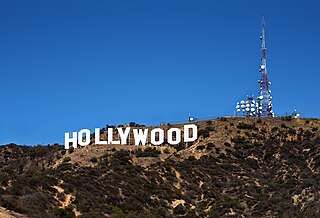
The Screen Actors Guild (SAG) was an American labor union which represented over 100,000 film and television principal and background performers worldwide. On March 30, 2012, the union leadership announced that the SAG membership voted to merge with the American Federation of Television and Radio Artists (AFTRA) to create SAG-AFTRA.
In United States labor law, a hostile work environment exists when one's behavior within a workplace creates an environment that is difficult or uncomfortable for another person to work in, due to illegal discrimination. However, a working environment that is unpleasant and frightening for the victim due to sexual advances that have been denied by the victim, is what constitutes hostile work environment sexual harassment. Common complaints in sexual harassment lawsuits include fondling, suggestive remarks, sexually-suggestive photos displayed in the workplace, use of sexual language, or off-color jokes. Small matters, annoyances, and isolated incidents are usually not considered to be statutory violations of the discrimination laws. For a violation to impose liability, the conduct must create a work environment that would be intimidating, hostile, or offensive to a reasonable person. An employer can be held liable for failing to prevent these workplace conditions, unless it can prove that it attempted to prevent the harassment and that the employee failed to take advantage of existing harassment counter-measures or tools provided by the employer.

Sexual harassment is a type of harassment involving the use of explicit or implicit sexual overtones, including the unwelcome and inappropriate promises of rewards in exchange for sexual favors. Sexual harassment can either be physical or verbal, maybe even both. Sexual harassment includes a range of actions from verbal transgressions to sexual abuse or assault. Harassment can occur in many different social settings such as the workplace, the home, school, or religious institutions. Harassers or victims may be of any sex or gender.

The U.S. Equal Employment Opportunity Commission (EEOC) is a federal agency that was established via the Civil Rights Act of 1964 to administer and enforce civil rights laws against workplace discrimination. The EEOC investigates discrimination complaints based on an individual's race, color, national origin, religion, sex, age, disability, genetic information, and retaliation for participating in a discrimination complaint proceeding and/or opposing a discriminatory practice.

Nikola Jean Caro is a New Zealand film, television, and music video director and screenwriter. Her 2002 film Whale Rider was critically praised and won a number of awards at international film festivals. She directed the 2020 live action version of Disney's Mulan, making her the second female and the second New Zealand director hired by Disney to direct a film budgeted at over $100 million. Caro's works ranged from music videos, commercials, television dramas, and films, etc.
Employment discrimination law in the United States derives from the common law, and is codified in numerous state, federal, and local laws. These laws prohibit discrimination based on certain characteristics or "protected categories." The United States Constitution also prohibits discrimination by federal and state governments against their public employees. Discrimination in the private sector is not directly constrained by the Constitution, but has become subject to a growing body of federal and state law, including the Title VII of the Civil Rights Act of 1964. Federal law prohibits discrimination in a number of areas, including recruiting, hiring, job evaluations, promotion policies, training, compensation and disciplinary action. State laws often extend protection to additional categories or employers.
Maria Giese is an American feature film director and screenwriter. A member of the Directors Guild of America, and an activist for parity for women directors in Hollywood, she writes and lectures about the under-representation of women filmmakers in the United States.
Workplace harassment is the belittling or threatening behavior directed at an individual worker or a group of workers.

Bernice Resnick Sandler was an American women's rights activist. She is best known for being instrumental in the creation of Title IX, a portion of the Education Amendments of 1972, in conjunction with representatives Edith Green and Patsy Mink and Senator Birch Bayh in the 1970s. She has been called "the Godmother of Title IX" by The New York Times. Sandler wrote extensively about sexual and peer harassment towards women on campus, coining the phrase "the chilly campus climate".

LGBT employment discrimination in the United States is illegal under Title VII of the Civil Rights Act of 1964; employment discrimination on the basis of sexual orientation or gender identity is encompassed by the law's prohibition of employment discrimination on the basis of sex. Prior to the landmark cases Bostock v. Clayton County and R.G. & G.R. Harris Funeral Homes Inc. v. Equal Employment Opportunity Commission (2020), employment protections for LGBT people were patchwork; several states and localities explicitly prohibit harassment and bias in employment decisions on the basis of sexual orientation and/or gender identity, although some only cover public employees. Prior to the Bostock decision, the Equal Employment Opportunity Commission (EEOC) interpreted Title VII to cover LGBT employees; the EEOC determined that transgender employees were protected under Title VII in 2012, and extended the protection to encompass sexual orientation in 2015.

Inequality in Hollywood refers to the various forms of discrimination and social inequality in the American media industry. There are many branches of the media industry, such as news, television, film, music, agencies, studios, to name some of the major players. In each one of these branches, there are many instances of inequality since Hollywood formed as the entertainment hub of America in the early 1900s.

Women are involved in the film industry in all roles, including as film directors, actresses, cinematographers, film producers, film critics, and other film industry professions, though women have been underrepresented in creative positions.
Sexual harassment in the workplace in US labor law has been considered a form of discrimination on the basis of sex in the United States since the mid-1970s. There are two forms of sexual harassment recognized by United States law: quid pro quo sexual harassment and behavior that creates a hostile work environment. It has been noted that a number of the early sexual harassment cases were brought by African American women and girls.
Women in documentary film describes the role of women as directors, writers, performers, producers, and other film industry professions. According to a 2017 study by San Diego University's Center for the Study of Women in Television and Film, women make up around thirty percent of the population of people working in the documentary film industry, worldwide. In a separate study on the employment of women in indie films, the Center found that overall fewer woman directed independent films were screened at film festivals but that a higher percentage of woman directed documentary films were screened, at 8 films versus 13 documentary films directed by men. In an October 2015 Annenberg study, women documentarians in countries other than the U.S. were 40 percent likely to be “helmers” as opposed to 30 percent likely in the U.S. The study counted films with multiple countries involved “as other countries” but if the U.S. was involved it wasn't counted as “other countries.”

This Changes Everything is a 2018 American documentary film, directed by Tom Donahue. An examination of sexism in the Hollywood film industry, the film interviews a variety of actresses and women filmmakers on their experiences in the industry.

Douglas Holden Wigdor is a founding partner of the law firm Wigdor LLP, and works as a litigator in New York City, specializing in anti-discrimination law. Wigdor is best known for representing seven victims of alleged sexual abuse by Harvey Weinstein, the hotel maid in the Dominique Strauss-Kahn sexual assault case, over twenty employees at Fox News in sexual harassment and discrimination cases, and former Miami Dolphins head coach Brian Flores in a 2022 class action lawsuit against the National Football League alleging racist and discriminatory practices against Black coaches.

Martha M. Lauzen is an American academic and researcher in the field of women in film.
The Original Six are a group of women directors who created the Women's Steering Committee (WSC) of the Directors Guild of America (DGA). Dolores Ferraro, Joelle Dobrow, Lynne Littman, Nell Cox, Susan Bay Nimoy and Victoria Hochberg formed the Women's Steering Committee of the Directors Guild of America in 1979. They carried out landmark research showing that women held only 0.5% of directing jobs in film and television, which they reported to the Guild, the studios and the press.
Kalpana Kotagal is an American employment attorney who is a commissioner of the Equal Employment Opportunity Commission.
Brainwashed is a 2022 American documentary film, directed by Nina Menkes. The writer-director "developed her 2017 essay and PowerPoint presentation into a film, examining the biased ways in which women are represented onscreen versus men." Using clips from hundreds of movies, Menkes explores the sexual politics of cinematic shot design; she also includes interviews with women and nonbinary artists, film theorists, and scholars, who discuss "the exploitative effects of the male gaze."











